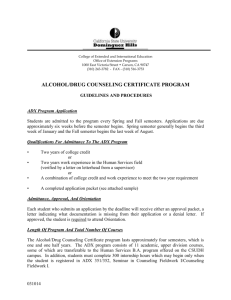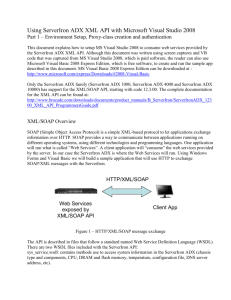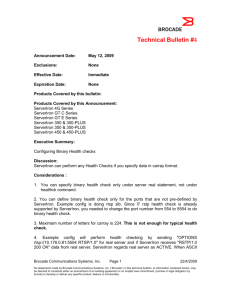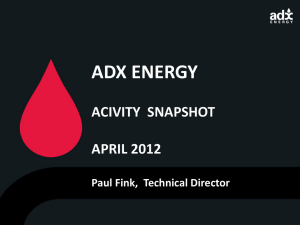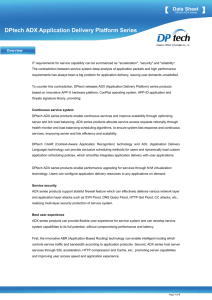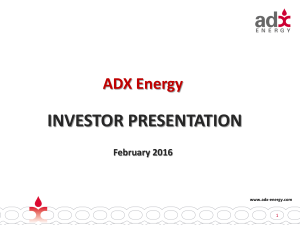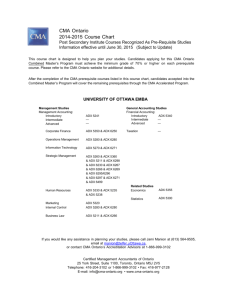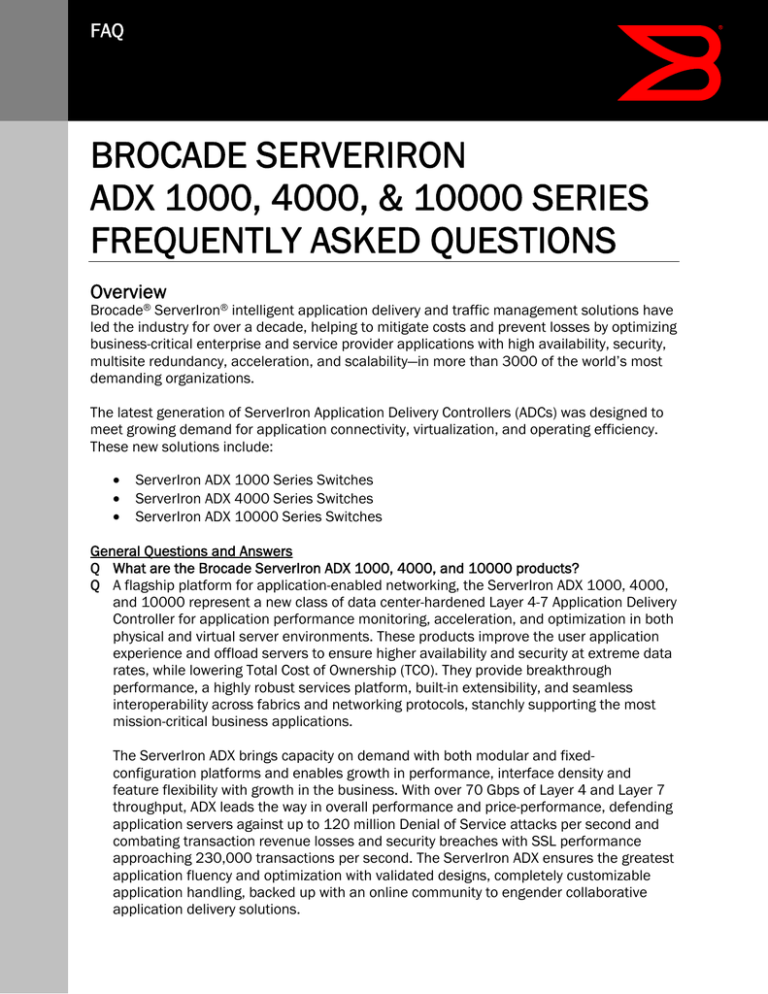
FAQ
BROCADE SERVERIRON
ADX 1000, 4000, & 10000 SERIES
FREQUENTLY ASKED QUESTIONS
Overview
Brocade® ServerIron® intelligent application delivery and traffic management solutions have
led the industry for over a decade, helping to mitigate costs and prevent losses by optimizing
business-critical enterprise and service provider applications with high availability, security,
multisite redundancy, acceleration, and scalability—in more than 3000 of the world’s most
demanding organizations.
The latest generation of ServerIron Application Delivery Controllers (ADCs) was designed to
meet growing demand for application connectivity, virtualization, and operating efficiency.
These new solutions include:
•
•
•
ServerIron ADX 1000 Series Switches
ServerIron ADX 4000 Series Switches
ServerIron ADX 10000 Series Switches
General Questions and Answers
Q What are the Brocade ServerIron ADX 1000, 4000, and 10000 products?
Q A flagship platform for application-enabled networking, the ServerIron ADX 1000, 4000,
and 10000 represent a new class of data center-hardened Layer 4-7 Application Delivery
Controller for application performance monitoring, acceleration, and optimization in both
physical and virtual server environments. These products improve the user application
experience and offload servers to ensure higher availability and security at extreme data
rates, while lowering Total Cost of Ownership (TCO). They provide breakthrough
performance, a highly robust services platform, built-in extensibility, and seamless
interoperability across fabrics and networking protocols, stanchly supporting the most
mission-critical business applications.
The ServerIron ADX brings capacity on demand with both modular and fixedconfiguration platforms and enables growth in performance, interface density and
feature flexibility with growth in the business. With over 70 Gbps of Layer 4 and Layer 7
throughput, ADX leads the way in overall performance and price-performance, defending
application servers against up to 120 million Denial of Service attacks per second and
combating transaction revenue losses and security breaches with SSL performance
approaching 230,000 transactions per second. The ServerIron ADX ensures the greatest
application fluency and optimization with validated designs, completely customizable
application handling, backed up with an online community to engender collaborative
application delivery solutions.
The ServerIron ADX product family includes:
• Brocade ServerIron ADX 1000: This 1U ADC can be ordered in numerous
configurations ranging from the entry-level ADX 1008-1 with eight 10/100/1000
BASE–T ports, one application processor, and one AC or DC power supply, all the way
up to the ADX 1216-4, with 16 10/100/1000 BASE–T ports, two 10 GbE XFP ports,
four application processors, as well as SSL acceleration hardware, and GSLB (Global
Server Load Balancing), Layer 3 and IPv6 software.
• Brocade ServerIron ADX 4000: A 4U chassis configuration with one switch fabric
module, one AC or DC power supply, and one fan module. It can be configured with
one management module with a dual-core processor, up to two application switching
modules (each with four dual-core processors), one switch fabric module, either two
4-port 10 GbE XFP line cards, two 12-port GbE RJ45 line cards, two 12-port GbE SFP
line cards, or a combination of two of those three options, and up to two AC or DC
power supplies.
• ServerIron ADX 10000: A 10U chassis configuration with two switch fabric modules,
two AC or DC power supplies, and one dual-fan module. It can be configured with up
to two management modules (each with dual-core processors), up to four application
switching modules (each with four dual-core processors), either four 4-port 10 GbE
XFP line cards, four 12-port GbE RJ45 line cards, four 12-port GbE SFP line cards, or
any combination of up to four modules consisting of those three options, and up to
four AC or DC power supplies.
Q What is ServerIron ADX 1008-1?
A To enrich the ADX product line with an innovative entry-level offering, the ADX 1000 1U
fixed configuration platform was enhanced with a license based capacity on demand
system. The ADX 1000 can be ordered in the traditional factory-licensed configurations
ranging from the new, value-priced entry-level ADX 1008-1 with 8 10/100/1000 BASE–T
ports, one application processor, and one AC or DC power supply, all the way up to the
ADX 1216-4, with 16 10/100/1000 BASE–T ports, two 10 GbE XFP ports, four
application processors, as well as SSL acceleration hardware, GSLB (Global Server Load
Balancing), Layer 3 and IPv6 software.
However, in addition to these traditionally ordered factory configurations, any ADX 1000,
beginning with the new ADX 1008-1, can now be upgraded to any higher configuration
through instant software-based license activation pay-as-you-grow options, without
removing the switches from service—another example of the many ways Brocade
continues to deliver superior customer choice and investment protection.
Q What is ADX release 12.2?
A Brocade continues to innovate with new features and functionality for Enterprise and
Service Provider networks in its application delivery product line. The 12.2 release
includes IPv6 gateway functionality (v6 to v4 and v6 to v4+v6), IPv6 Syn-Proxy capability,
extends L7 CSW scripting to non-HTTP protocols such as FIX protocol, enhances
Transparent Cache Switching (TCS), adds response time based load balancing algorithm,
and the Web GUI management additions such as simplified code upgrade and generic
HTTP template, along with numerous new features, tested or certified interoperable with
2 of 14
the leading technology partners and enterprise business applications and significantly
extending the range of solutions this powerful platform can provide.
Q What is Application Resource Broker?
A Working in tandem with ServerIron ADX, Brocade Application Resource Broker (ARB), is
an infrastructure software component used by IT operations staff who seek simplified,
on-demand application resource provisioning and de-provisioning within their data
centers. ARB assures adherence to application Service Level Agreements by dynamically
adding and removing application resources (VM’s) based on real-time monitoring of
infrastructure capacity and responsiveness.
Q What is the business case for this product?
A In tandem with ServerIron ADX, ARB delivers the key enabling technology to provide ondemand services within a shared-infrastructure data center—commonly referred to as an
enterprise cloud. Brocade is enabling business-oriented and SLA-assured application
delivery with dynamically provisioned application infrastructure resources to
accommodate variable traffic loading for current and high-growth services. This
technology can reduce or eliminate the inefficiencies and high cost of provisioning for
peak load across thousands of applications, while ensuring resiliency in the delivery of
those services, and avoiding missed SLAs due to under-provisioning. Typical savings
include reduced intervention costs when remediating estimation errors and application
SLA issues, reduced power, cooling, space to service existing traffic demands and more
efficient infrastructure that can absorb the delivery of new business processes or
increased traffic without incurring additional capital expense.
Q What is the key or distinguishing feature of Application Resource Broker?
A As an extension to Brocade ServerIron ADX application delivery controllers, Application
Resource Broker can dynamically add and remove application resources when needed,
based on application traffic demands. This is achieved through real-time correlation of
application performance from the network and infrastructure capacity information from
server infrastructures like VMware. The Resource Broker leverages ADX’ unique position
in the network to provide real-time monitoring of application loading that drives
immediate, intelligent, and impactful response to changing application traffic demands.
This ultimately assures highly reliable service levels between end users and application
infrastructure without incurring the high cost of over-provisioning. The unique
combination of ServerIron ADX with Application Resource Broker associates the various
application components to their respective virtualized resources, enabling true
application-level visibility for IT operations. It is this pairing of application-centric visibility
with automated, on-demand provisioning that enables an on-demand virtualized IT
infrastructure.
Q Does Application Resource Broker support VMware vSphere 4.0
A Yes, Application Resource Broker supports vSphere/ESX 4.0
Q Will Application Resource Broker support other virtualization and orchestration
environments?
A Yes. As a proponent of standards-based compatibility and interoperability with the
widest range of virtualization and orchestration vendors, and to ensure customer choice
and flexibility, it is our intention to support other orchestration tools in the future
3 of 14
Q When do these products become generally available?
A The ADX series became generally available on July 1, 2009 through Brocade Distributors
and Resellers. The ADX release 12.2, the ADX 1008-1, ADX capacity-on-demand
upgrade activation, and the Application Resource Broker will be generally available at the
beginning of the second half of 2010.
Marketplace
Q Why is Brocade in the application delivery controller market and how does ADX fit into
the overall Brocade strategy?
A For the past decade, Brocade has brought technology leadership to Layer 4-7 switching
with more than 3000 high-profile customers. Building on a strategy of growth and
diversification, Brocade has been addressing the problem of growing data center
operational complexity resulting from increased consolidation and virtualization.
As server virtualization and the Enterprise cloud service model becomes commonplace
in production environments while the growth of Web-based applications and mobile
clients continues unabated, application delivery capacity, performance and management
requirements will multiply, particularly in the 10 GbE connectivity segment.
Brocade brings deep experience in the design, deployment, and management of highavailability, high-reliability data center networks—focusing on the client side of server
farm connectivity and management. Moreover, Brocade can deliver the right solutions to
this rapidly growing market segment based on decades of Local Area Network (LAN) and
Storage Area Network (SAN) experience, as well as a proven history of developing the
most robust products and services.
This rapidly growing segment is an integral component of service provider and enterprise
data center cloud services. As data centers become increasingly virtualized, application
delivery platforms must grow in capacity, performance and intelligence, to optimize
delivery for larger online customer volumes and growing numbers of enterprise
application users—all connecting to ever-increasing numbers of virtualized applications.
With the addition of Application Resource Broker, Brocade demonstrates continuing
focus on application delivery solutions that optimize the end user experience while
ensuring efficient resource usage.
In addition:
• Brocade already provides high-performance and high-availability data storage access;
fabric extensibility and robustness; and streamlined fabric management for the most
demanding business applications. Adding Web client access, security, IPTV, and
Voice over IP (VoIP) application delivery is a natural extension to this business.
• Brocade has been leading the evolution of data centers by delivering highly reliable,
high-performance core data center products and services for over a decade.
• The Brocade vision is aligned with current data center needs, with a singular focus on
securely managing, sharing, and protecting data.
4 of 14
•
•
Key elements of this vision are to simplify data networks and provide a foundation for
critical solutions—such as server virtualization, data mobility, and data protection—
running seamlessly without costly manual intervention or performance bottlenecks.
Intelligent application delivery plays a crucial role in the success of this end-to-end
vision, and will help Brocade provide high-performance hardware and software
products with proven interoperability.
Technologies
Q What is unique or advanced about the ServerIron ADX architecture?
Q Compared to the many competitive offerings, the ServerIron ADX switches deliver
extremely high application throughput based on an advanced design that features
complete physical and logical separation of the application and management planes. In
fact, the multichip, multicore, application processing plane is designed for the highest
core density and performance upgradability.
This architecture utilizes modular hardware design to accelerate application processing
and to optimize the distribution and flow of internal traffic to a large number of
application cores. The high-speed non-blocking switching fabric uniquely supports
application processing, I/O, and management modules to maximize flexibility. The data
plane provides high-density 10 Gbps support with hardware assist for linear session
distribution across multiple application cores. In addition, the management modules
feature field-upgradable mezzanine cards for Secure Sockets Layer (SSL), and other
planned future functions such as compression.
The ServerIron ADX switches are simple to configure and manage using the Brocade
Command Line Interface (CLI) or built-in browser-based interface. The CLI uses wellknown industry-standard syntax for fast error-free configuration. The switches support
Simple Network Management Protocol (SNMP) to allow device management using
applications such as HP OpenView and Brocade IronView® Network Manager (INM).
Q How does the ServerIron ADX improve network performance?
Q The ServerIron ADX switches use deep packet inspection and content transformation,
beyond the traditional Layer 2 and 3 packet headers, directing client requests to the
optimal servers. These intelligent Layer 4-7 application switches transparently support
any TCP- or UDP-based applications and provide specialized application acceleration,
server-offload, connection management, and network optimization.
The ServerIron ADX switches also provide a reliable line of defense by securing servers
and applications against many types of intrusion and attack without sacrificing
performance. In addition, they provide efficient traffic distribution among infrastructure
devices such as firewalls, DNS servers and cache servers. The ADX devices also deliver
high performance for higher-layer application switching functions. Intelligent content
switching capabilities include customizable rules based on URL, HOST, cookies and other
HTTP headers, XML, and application content.
5 of 14
Q What are the key performance advantages of ServerIron ADX switches?
A The ServerIron ADX architecture provides more application switching performance than
any previous application switch. Performance highlights include:
• Industry-leading performance with up to 14 million Domain Name System (DNS)
queries per second, 1.6 million Layer 4 connections per second, 16 million Layer 4
transactions per second, and up to 230,000 SSL TPS (transactions per second)
• Up to 70 Gbps of Layer 4 and Layer 7 application throughput—twice the throughput of
many competing vendors, making the switches ideal for demanding content delivery
and streaming media applications
• High 10 GbE port density with up to 16 10 Gbps ports in a single chassis
• Industry’s highest core density with up to 32 dedicated application cores for highperformance application delivery
• Industry leading Denial of Service (DoS) protection, generating up to 120 million SYN
cookies per second with no impact to CPU utilization
• Industry’s only 1U fixed-configuration ADC to offer capacity-on-demand to meet
changing business needs. The ADX 1000 support simple software upgrades for
application processors, hardware accelerators such as SSL, 1Gig and 10Gig
interface ports, and software features to scale up to 9 Gbps of application
throughput, up to 200,000 L4 connections per second, up to 29,000 SSL TPS and
two 10 GbE ports.
• The industry-leading price/performance value per rack unit and per watt of power
with the best cost/transaction and cost/Gbps of throughput
Key Benefits
A ServerIron ADX switches feature a unique architecture that supports scalability and
expansion to meet growing application delivey requirements with investment protection.
Key benefits include:
• High performance in a modular design: A choice of models starting with the compact
1U ServerIron ADX 1000 to the highly scalable ServerIron ADX 4000 and 10000
series with 320 Gbps of switching bandwidth
• Capacity on Demand: Scale system performance, activate software features and
1Gig and 10Gig ports as needs growRedundant power supplies: Support for
redundant, hot-swappable power supplies on all models—front-serviceable on the
ServerIron ADX 4000 and 10000
• Hot-swappable modules: Hot-swappable interface modules, fan trays, and power
supplies
• Interchangeable Modules: Module portability between two chassis platforms – ADX
4000 and ADX 10000. The management module, application switch module, switch
fabric module, interface modules and power supplies are completely interchangeable
• Hot-Standby and Active/active High Availability modes: Choice of three different high
availability modes for maximum reliability and service availability
• Upgradable to hardware-assisted SSL acceleration: Optional mezzanine application
expansion module add hardware-based SSL acceleration today, and other
acceleration modules that become available in future
• Reliability: A resilient switching and routing foundation with advanced support for RIP
2, OSPF 2 and 3 (IPv6), VRRP, and VRRP-E
• Flexible, scalable connectivity options: Expansion from 12 to 48 GbE ports in mixed
copper/fiber combinations, or up to 16 10 GbE XFP ports
6 of 14
Q How do ServerIron ADX switches improve ROI?
A The ServerIron ADX switches simplify server farm management and application upgrades
by enabling organizations to easily add resources and remove them into the pool—
helping to minimize TCO. The switches uniquely provide a single platform that can reduce
network load and extend server farm design and scalability.
They accomplish this by combining a high-performance Layer 4-7 packet processing
architecture with the highest available throughput via 1 GbE and 10 GbE connectivity.
ServerIron ADX switches provide hardware-assisted, standards-based network
monitoring for all application traffic flows—improving manageability and security for
network and server resources. Extensive and customizable service health check
capabilities monitor Layer 2, 3, 4, and 7 connectivity—along with service availability and
server response time—to enable real-time problem detection. If a problem arises, client
requests are automatically redistributed to other servers capable of delivering optimized
service. This approach helps keep applications running smoothly with the maximum
availability.
ServerIron ADX switches also support many high-availability mode options, with real-time
session synchronization between two ServerIron ADX switches available to protect
against session loss during outages. As one device shuts down, the second device
transparently resumes control of client traffic with no loss to existing sessions or
connectivity. Organizations can use advanced synchronization capabilities to simplify the
management of two ServerIron ADX switches deployed in high-availability mode,
minimizing network downtime caused by configuration errors.
The intuitive browser-based GUI is easy to operate and can be used to rapidly deploy
ServerIron ADX switches and reliably set up basic configuration functions such as:
• Real server creation
• Virtual server creation
• Real-to-virtual server binding management
• Virtual/real server and port management
• L4 server load balancing
• L7 server load balancing (CSW)
• SSL key and certificate management and acceleration
• VLAN management and port assignment
• IP address configuration
• Standard Access Control List (ACL)
• Front panel view
• Live charts and statistics for real and virtual servers and ports
• Simplified software image upgrade
• Generic http application template
With intelligent application-aware load balancing and content switching capabilities,
ServerIron ADX switches significantly improve application and server farm performance
7 of 14
while increasing availability, security, scalability, and resource utilization. Key benefits
include:
• Improved infrastructure utilization: ServerIron ADX switches perform highly
customizable real-time health checks, dynamically monitoring the ability of servers to
optimize performance and transparently reacting to server farm congestion by
distributing client traffic loads to the most available servers. Intelligent content
switching maximizes server utilization and performance by eliminating the need to
replicate content and application functions on every server.
• Increased server availability: ServerIron ADX switches can be deployed in multiple
high-availability modes with hitless and stateful session synchronization and failover
to extend availability even through switch failures.
• Robust security: With built-in intelligence, ServerIron ADX switches detect and discard
viruses and worms that spread through application-level messages. The switches
load-balance legitimate application traffic while preventing and defeating attacks.
Through specialized embedded logic, the switches reliably protect against many
forms of DoS and Distributed DoS (DDoS) attacks at industry-leading data rates of up
to 32 million attack packets per second.
• Massive scalability: ServerIron ADX switches provide virtually unlimited scalability to
IP-based applications and server farms in a cost-effective manner. They allow the use
of multiple servers with load balancing and failover, eliminating forklift upgrades to
server farms and disruption to applications.
• Faster ROI: ServerIron ADX switches provide high ROI for application and server
infrastructure in a short timeframe, supporting significantly higher application traffic
and user loads on existing infrastructure by maximizing server resource utilization.
With support for server connection offload, the switches reduce connection
management overhead, freeing up resources for application processing and
improving overall server farm performance and capacity. On-demand and unlimited
virtual server farm scalability eliminates the need for forklift upgrades and
dramatically improves server infrastructure ROI.
Key Product Features
Q What are the differences between the various model configurations?
A The ServerIron ADX 1000 series switches come in fixed 1U form factor and can be
ordered in multiple configurations from a single application core in the ADX 1008-1 to up
to four application cores in ADX 1216-4. These can be scaled up through a pay-as-yougrow expansion model by activating software upgrade licenses. Customers can activate
up to four application cores, two 10GigE ports, up to sixteen 1Gig ports, SSL hardware
acceleration and GSLB, IPv6 and Layer 3 software receiving true investment protection
from the industry’s most flexible, high-performing 1U application delivery platform.
When reconfiguration, scaling, or expansion is required for extra high throughput and
CPS/TPS, the unique chassis design of the 4U ServerIron ADX 4000 and the 10U
ServerIron ADX 10000 provides a dedicated backplane to support application, data, and
management functionality and capacity expansion through specialized modules.
Q What kinds of modules are available for the ServerIron ADX chassis models?
A The following model-interchangeable Field Replaceable Units (FRUs) are available for
ServerIron ADX 4000 and 10000 chassis:
8 of 14
•
•
•
•
•
Management Module: ServerIron ADX Management Modules have a dual-core
processor, one console port, and one USB port, as well as space for an optional
Application Expansion Module.
SSL Application Expansion Module: This SSL hardware offload upgrade fits any
Management Module in either the 4U ADX 4000 or the 10U ADX 10000, enabling
two SSL AEMs to be populated in an ADX 10000 when two Management Modules are
installed
Application Switch Module: Each ServerIron ASM8 module is equipped with four dualcore processors dedicated to processing application traffic. Up to four ASM8 modules
can reside in the ServerIron ADX 10000 for a total of 32 available cores.
Switch Fabric Module: Each of the switch fabric module deliver 160 Gbps fo raw
switching capacity, giving up to 320 Gbps of raw switching with ADX 10000 chassis
providing scalability as I/O modules require more bandwidth.
Interface Modules: Three configurations of ServerIron ADX line cards are available:
• 12×1 Gbps copper (RJ45)
• 12×1 Gbps fibre (SFP)
• 4×10 Gbps fibre (XFP)
The ServerIron ADX chassis can scale to support even higher capacity I/O in the future as
40 Gbps and 100 Gbps line card interfaces become available.
Q Can these modules be used on both the ServerIron ADX 4000 and 10000 chassis?
A Yes. All modules can be used interchangeably on these chassis.
Q What application switch features does the ServerIron ADX platform provide?
A ServerIron ADX switches support a wide range of IP and Web traffic management
applications by providing the following capabilities:
• Efficient Server Load Balancing (SLB): Distributes IP-based application flows and
transparently balances traffic among multiple servers while continuously monitoring
server, application, and content health to increase reliability and availability.
• Intelligent application content inspection and switching: Avoids replicating application
content and functions on all servers, while scaling and optimizing performance. It
also helps defeat application-level attacks by using deep Layer 7 content inspection
and filtering of application messages.
• Disaster recovery and Global Server Load Balancing (GSLB): Distributes services
transparently across multiple sites and server farm locations, balancing traffic on a
global basis while monitoring site, server, and application health. By directing clients
to the best site for the fastest content delivery, ServerIron ADX switches increase
application availability and reduce bandwidth costs. Moreover, site-level redundancy
and fast transparent failover facilitate disaster recovery.
• Robust application security: Shields server farms and applications from wire-speed
multi-Gigabit-rate DoS, DDoS, virus, and worm attacks while serving legitimate
application traffic at peak performance.
• Enterprise applications: Supports enterprise environments running IP- and Webbased applications, including popular applications such as Oracle, BEA Web Logic,
IBM WebSphere, PeopleSoft, SAP, Microsoft SharePoint, and Siebel. ServerIron ADX
switches enable load balancing and persistence to improve availability, security, and
performance.
9 of 14
•
•
•
•
•
•
•
•
•
SYN-Guard: Protects server farms against multiple forms of DoS attacks, such as
TCPSYN and ACK attacks, by monitoring and tracking session flows. Only valid
connection requests are actually sent to servers. ServerIron ADX switches are
capable of defeating DoS attacks at the industry’s highest rate of up to 120 million
SYN/sec.
High-availability application switching: Utilizes active-standby mode, whereby the
standby ServerIron ADX switch assumes control and preserves the state of existing
sessions in the event the primary load-balancing device fails. In active-active mode,
both ServerIron ADX switches work simultaneously and provide a backup for each
other while supporting stateful failover.
HTTP multiplexing (server connection offload): Increases server performance,
availability, response time, and security by offloading connection management from
the servers. Using persistent HTTP 1.0 and 1.1 connections to the server, ServerIron
ADX switches stream a large number of client connections to very few server
connections. Connection offload enables the servers to dedicate resources for highperformance application content delivery.
Application rate limiting: Protects server farms by controlling the rate of TCP and UDP
connections on an application-port basis, thereby guarding against malicious attacks
from high-bandwidth users.
High-performance access control: Uses extended ACLs to restrict access to specific
applications from a given address or subnet.
Application redirection: Uses HTTP redirect to send traffic to remote servers if the
requested service or content is not available on the local server farm.
Hardware SSL acceleration: Utilize dedicated SSL hardware for high-performance SSL
offload, both in SSL terminate and proxy modes
Advanced firewall and security device load balancing: Increases firewall and
perimeter security performance by distributing Internet traffic loads across multiple
firewalls and other perimeter security appliances. This approach overcomes
scalability limitations, increases throughput, and improves resiliency by eliminating
perimeter security devices—such as firewalls, anti-virus gateways, VPN devices, and
intrusion appliances—as single points of failure.
Transparent Cache Switching (TCS): Balances Web traffic across multiple caches,
eliminating the need to configure each client browser, improving Internet response
time, decreasing WAN access costs, and increasing overall Web caching solution
resiliency. ServerIron ADX switches improve service availability by implementing
cache health checking, redirecting client requests to the next available cache server
or directly to the origin server in the event of a cache or server farm failure.
Q Do ServerIron ADX switches provide SSL offload and application server acceleration?
A The ServerIron ADX 1000, 4000, and 10000 series, provide industry-leading highperformance SSL offload, in both SSL terminate and SSL proxy modes. The ADX 1000
models 1008-1, 1016-2, 1016-4 and 1216-4, that is shipped post February 1st, 2010, is
shipped with built-in SSL hardware and can be upgraded for SSL offload through simple
software license upgrade. The ADX 4000 and ADX 10000 chassis can be field-upgraded
for SSL by adding an SSL expansion module on top of the management module. The ADX
1000 with 4 application cores can process up to 28,672 TPS (transactions per second),
and the ADX 10000 chassis with two SSL expansion modules can process up to
230,000 SSL TPS.
10 of 14
Q How many SSL keys and certificates can be used with ServerIron ADX solution?
The ServerIron ADX SSL supports up to 4096 SSL certificates and 4096 SSL keys,
assuming the length of each to be 1024 bytes. These SSL certificates and keys can be
managed through the element manager (web GUI), Brocade IronView Network Manager
(INM) and the command line interface (CLI),. The graphical interface available through
either the web GUI or INM is generally preferred; as it offers a simplified and secure
method for certificate/key uploads and downloads.
Q Can ServerIron ADX SSL offer end-to-end security by establishing a secure SSL channel
with the backend application server while offloading SSL processing?
A Yes, ServerIron ADX SSL can be configured in one of the two modes – terminate and
proxy. In proxy mode, ServerIron terminates the incoming SSL traffic, identifies the
backend application server based on configured Layer4 or Layer7 rules, and then reencrypts the traffic for backend server communication. This ensures complete end-toend security for highly sensitive applications.
Q Do ServerIron ADX series switches process next-generation IPv6 traffic as well as IPv4?
A Yes, ServerIron ADX 1000, 4000, and 10000 series enable application delivery for IPv6
services by offering the following functionality:
• Full Layer 4 and Layer 7 load balancing for IPv6 VIPs (v6 VIPs and v6 Reals)
• IPv6 Pass-through traffic handling
• IPv6 Management (telnet, SSHv2 etc)
• IPv6 Routing (static routes, OSPFv3, VRRP-E etc)
• IPv6 to IPv4 translation and gateway functionality (v6 VIPs and v4 Reals or v6 VIPs
and v4 and v6 Reals)
• IPv6 Syn-Proxy
• IPv6 Route Selection through Router Advertisements
ServerIron ADX provides Layer 4-7 processing for IPv4 and IPv6 traffic by pre-processing
the IPv6 packets to be handled by the high-performance IPv4 L4-7 processing engine.
After Layer 4-7 finishes processing the packet, or if ADX determines that this packet is
not a candidate for Layer 4-7 processing (pass-through), then the IPv4 packet is postprocessed back to an IPv6 packet and sent on to its destination. Post-processing is
completed after Layer 4-7 or pass-through traffic processing is finished and before the
packet exits the ADX. In pre-processing, IPv6 addresses can be remapped to IPv4
addresses either through static or dynamic mapping address pools.
Q How is the Management Port used on ServerIron ADX? Can it be used for Data Traffic?
A ServerIron’s dedicated management port allows for out-of-band management of the ADX
using telnet, SSHv2, SNMP, HTTP or HTTPS protocol, so that full management
functionality and control is enabled without degrading its traffic processing performance.
The management port cannot be used for data traffic processing.
Q What is the maximum number of contexts (or administrative domains) that I can define
using the Role Based Management feature?
11 of 14
A ServerIron ADX permits the definition of up to 256 contexts, roles or soft partitions. ADX
administrators in any one domain are isolated from the others and have no visibility into
the objects or services running within those other contexts.
Q Can I configure a single-port LACP trunk on ServerIron?
A Yes. ServerIron ADX allows the creation of a single-port LACP trunk, a popular diagnostic
technique for unidirectional link failure detection.
Q Can I configure a multi-slot trunk starting with any port number?
A Yes. ServerIron ADX offers great flexibility for trunk definition, allowing the creation of
trunks with odd or even numbers of member ports, beginning with an odd or even
numbered port. Additionally, trunks can be created across member ports that are
spread over multiple line modules inside the ServerIron chassis.
Q Do ServerIron ADX switches provide Global Server Load Balancing (GSLB)?
A All ServerIron switches, including the ADX 1000, 4000, and 10000 series, can redirect
client traffic geographically among multiple sites based on availability, load, and
response time. These switches also measure client/server proximity as defined by roundtrip delay and geographic location. All these features can work in conjunction with the
network’s existing DNS servers, minimizing network disruption when implementing
GSLB. ServerIron ADX switches continually monitor multiple sites to detect any changes
in servers or services due to varying health and traffic conditions. Configurable site load
thresholds enable organizations to align health checking parameters with each site’s
server and service capabilities.
In addition, ServerIron ADX switches use geographic site selection to keep requests
within continental domains. Continuous application traffic monitoring helps create a
dynamic knowledge base that enables more intelligent GSLB methodologies and site
selection criteria.
The ServerIron ADX GSLB software provides the following key functions:
• Acts as a DNS proxy to transparently intercept and modify the DNS responses,
thereby directing users to the best site
• Leverages existing DNS servers and minimizes disruption to the existing DNS
environment
• Provides continuous site monitoring to detect changes in site health conditions
• Provides configurable settings to fine-tune individual site load thresholds
• Monitors and selects sites by measuring site, server, and application responsiveness
• Adds an evolutionary knowledge base that enables more intelligent site selection as
more clients access the site
In addition, ServerIron ADX switches provide a unique multisite redundancy solution with
Virtual IP (VIP) Route Health Injection. This capability matches VIP and server health with
intelligent route propagation to the Internet through standards-based routing protocols.
This approach provides business continuity to IP applications that do not rely on DNS for
service name resolution.
12 of 14
ServerIron ADX GSLB is one of the best solutions available to ensure business continuity
across multiple data centers.
Q Can I run IPv6 and GSLB with Layer 2 switch code?
A Yes, IPv6 and GSLB controller functions can be executed on Layer 2 switch code.
However these features must be activated through the Premium software license
upgrade. Running Layer 3 router code for IPv6 and GSLB functionality is not mandatory.
Q Can I enable HA (high availability) for IPv6 traffic?
A Yes, you can enable any of the three high-availability modes for session synchronization
of IPv6 traffic between the peer HA units.
Q Does ServerIron ADX support Layer 7 inspection and load balancing on non-HTTP
protocol?
A Yes, the ServerIron ADX supports content switching CSW for Layer7 inspection and traffic
switching of HTTP as well as non-HTTP protocols. As an example, CSW can be utilized to
do traffic redirection based on SenderCompeID value in FIX (Financial Information
eXchange) protocol.
Q What are the available load balancing algorithms for server load balancing with ADX?
A ServerIron ADX supports the following load balancing predictors:
o Least Connection
o Round Robin
o Weighted Round Robin
o Weighted
o Enhanced Weighted
o Dynamic Weighted (SNMP based)
o Response Time
Q Does the ADX 1000 ship with embedded SSL hardware?
A Yes, on Feb 1, 2010 all ADX 1000 units began shipping with embedded SSL hardware,
to allow for future SSL activation without requiring costly hardware upgrade.
Q What is the maximum size of SSL certificate chain?
A The maximum count of certificates in the SSL certificate chain while doing SSL offload on
ADX is 10.
Q Can I apply Layer 7 rules for transparent cache switched traffic?
A Yes, you can utilize advanced Layer 7 content switching CSW capabilities of ServerIron
ADX with transparent cache switching (TCS) function to redirect TS traffic based on
Layer7 rules.
Key Success Factors Supporting Data Center Virtualization and Orchestration
Q How is Brocade positioned to succeed in the market for application optimization within a
cloud services infrastructure?
13 of 14
A Brocade has a well-established track record in providing impressive ADC performance
and superior ROI to the largest service providers. In addition, Brocade is leveraging its
strategic relationships with OEM, technology, and channel partners that all value a single
qualification or certification process that saves time and money.
A Application Resource Broker goes beyond adding simple support for server virtualization.
In fact, it is a given that ServerIron provides equal optimization support to applications
whether they are running on a virtual, or a real server. Brocade recognizes that resource
consolidation through server virtualization is only the initial step towards keeping up with
the rapid increase in the number of client connections to richer media, in more complex
computing environments, and with more stringent business requirements.
As customers consider their migration to this next generation of application architecture,
to realize the full potential of the cloud model built on a service-oriented network
infrastructure, they will need technology partners who can demonstrably reduce risk,
operational cost and complexity, while increasing (and decreasing) application capacity
on-demand, in an elastic, service-oriented resource infrastructure.
With Application Resource Broker, Brocade is leading the way with demand-driven
application provisioning, and bringing value and insight that only ADX, with its intense
focus on client-server connection dynamics, can bring to the orchestration Layer. And, as
a leader in data center networking, Brocade is uniquely positioned to provide these key
benefits:
•
•
Standards-based compatibility and interoperability with the widest range of
virtualization and orchestration vendors, ensuring choice and flexibility
Field-proven service and support for the most challenging six-nines environments
Q What are Brocade’s future plans for the ADC market?
A Brocade is committed to a long-term investment in application delivery, with plans for a
growing product line. In all segments where Brocade competes, the goal is to lead and to
remain at the forefront of the marketplace.
Q What kinds of support and services are available for ServerIron ADX switches?
A Brocade offers a portfolio of professional and customer support services to help
organizations deploy and maintain highly efficient and resilient IP network
infrastructures. Brocade Global Services provides a full suite of offerings covering the
lifecycle of network assessment, design, and implementation to help organizations
develop the best architecture to meet their unique requirements.
Q How do I find out more about ServerIron ADX application delivery products and
solutions?
A Contact your Brocade Sales Representative or OEM Partner for details, or visit
www.brocade.com/adx
© 2010 Brocade Communications Systems, Inc. All Rights Reserved. 04/10
Brocade, the B-wing symbol, BigIron, DCX, Fabric OS, FastIron, IronPoint, IronShield,
IronView, IronWare, JetCore, NetIron, SecureIron, ServerIron, StorageX, and TurboIron are
registered trademarks, and DCFM, Extraordinary Networks, and SAN Health are
trademarks of Brocade Communications Systems, Inc., in the United States and/or in
other countries. All other brands, products, or service names are or may be trademarks or
service marks of, and are used to identify, products or services of their respective owners.
14 of 14


